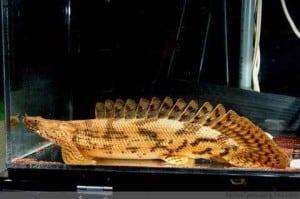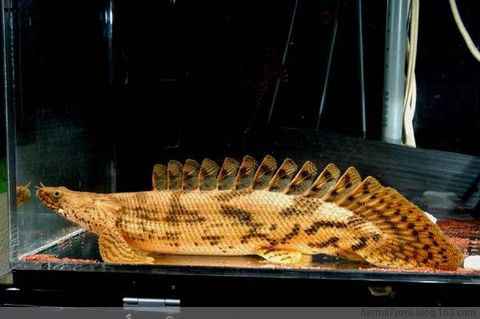
Common name: Saddled Bichir
Scientific name: Polypterus Endlicheri Endlicheri
Average Adult Fish Size: 30 inches / 75 cm
Place of Origin: A widespread species, it has been recorded in Cameroon, Nigeria, Burkina Faso, Ghana, Chad, The Ivory Coast, Mali, Sudan, Benin and the Central African Republic. It inhabits rivers and marshy areas and is occasionally found in brackish conditions, particularly in areas of mangrove.
Typical Tank setup: Plants are unnecessary, but appreciated as they provide shade in the aquarium. Bichirs are mainly nocturnal, and bright lighting is not appreciated. If you wish to have live plants, use tall and sturdy varieties that offer shade, and have substantial root sytems. Protect the base of them with rock work or substantially sized pieces of bogwood/driftwood. Along with plants a well decorated aquarium that has a lot of caves made up of rock work and or bogwood/driftwood will keep a Bichir happy and healthy.
Recommended Minimum Aquarium Capacity: Juveniles can easily be kept in aquariums as small as a 20 gallon /80 litre, but full grown adults need an aquarium with large base dimensions measuring at least 6 feet x 2.5 feet / 180 cm x 75 cm , or 250 gallon / 1000 litre. Depth is not as important as “floor space”.
Compatibility: All Bichirs are relatively peaceful with other fish that are too large too eat. They will eat others of their own kind given the chance though, so other Bichir tankmates should be close to the same size. Sometimes Bichirs will squabble among themselves over food, but rarely is any damage done.
Temperature: 74 – 82 Deg F / 23 – 28 Deg C
Water chemistry: pH 6.0 – 8.0
Feeding: Feed meaty live foods such as black worms, blood worms, and earthworms along with frozen foods such as brine shrimp, mysis shrimp, and beef heart. Dried foods are not always accepted, but eventually most Bichirs will accept a quality pellet, tablet, or stick that is suitable to their size. Bichirs are slow to find food as they have poor eyesite. They hunt in the wild predominantly by using smell.
Sexing: The anal fin of the male is thicker than that of the female
Breeding: Has been achieved in aquaria but details are very scarce. As this species breeds during the rainy season in nature, changes in the temperature and chemistry of the water are likely to induce spawning behaviour. A large tank is required and should contain soft, slightly acidic water. It is an egg scatterer and therefore areas of dense planting and/or spawning mops should be provided. During spawning itself, the male receives the eggs from the female by cupping his anal and caudal fins around her genitals. He then fertilises the eggs before scattering them amongst vegetation. At this point the adult fish should be removed, as they may predate upon the eggs. The eggs hatch in 3-4 days, with the fry becoming free swimming around 3 days later. First foods should be baby brine shrimp (BBS) or microworms. Apparently the fry are not particularly mobile, so care should be exercised to ensure they are well fed.
Additional Information: It should be noted that most Polypterus offered for sale are wild caught and as such, may come in carrying infections or parasites. Keep a close eye on new fish for the first few weeks after purchase. Always make sure the aquarium is tightly covered with no open holes or means of escape. Bichirs are messy eaters, so provide good filtration and frequent partial water changes to maintain good water quality. Even though they are bottom dwellers, they must be able to surface when they feel like it. This is because they breathe oxygen from the air as well. Always ensure that your Bichir has enough room to go up for a fresh breath of air. Coloration of this species range from grey, to tan, to even brown and come in long bodied, short bodied, and super short bodied versions.


Related Posts
Croaking Gourami – Trichopsis vittatus
Benthochromis Tricoti
Large-eyed Mouthbrooder – Callochromis Macrops